deaf culture
Let them hear the promises of God
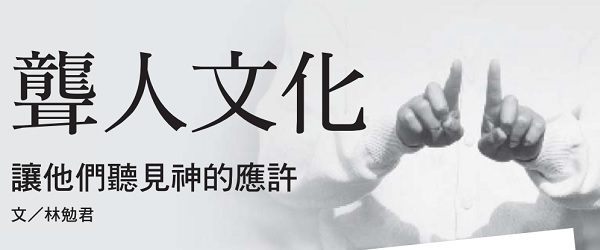

The world of hearing people is noisy, but the world of deaf people is peaceful; hearing people listen to beautiful music with their ears, but deaf people use their hearts to feel the vibration of drum beats. Unless they learn sign language and enter the world of the deaf, it will be difficult for hearing people to understand the world and culture of the deaf.
Unique and visually oriented
自從1980年代美國興起聾人文化1,之後,歐洲和亞洲部分國家也跟進推行,對聾人群體各方面的發展起了相當積極的作用。聾人文化的核心乃是聾人的語言─手語。當聾人認識到自己是擁有獨特語言及文化的群體時,他們不再因聽力障礙而自卑,反而產生自信,進而發展出潛能及才華,這乃是聾人文化的精髓所在。
Behind every language there is a cultural system. Many foreigners learn Chinese and have a good command of the words, but they may become clueless when encountering some historical allusions. If a Chinese says to an American, "The stinky tofu sold at the night market is delicious." How can a foreigner understand the true meaning of this sentence unless he has actually tasted the stinky tofu at the night market? Isn’t it true that Chinese people learn English? The key is culture. If you don’t learn a good culture when learning a language, sometimes it’s like a blind man trying to grasp an elephant, unable to grasp the true meaning of the language. Many people may not understand that there is a cultural system behind sign language, the language of the deaf. If hearing people want to learn sign language, especially a sign language interpreter, in addition to mastering the language of the deaf, they also need to have an in-depth understanding of the culture of the deaf.
臺灣聾人領袖趙玉平(1997)認為:「文化的產生,肇始於血統、語言和生活習慣,而以語言的影響力最為重大。不同的語言產生不同風格國度社區的文化,也深深決定了此種文化的內涵。聾人以手語為母語,加上聽覺障礙,無法或難以接受聲音訊息的刺激,在無聲當中完全依賴視覺吸收資訊的情況下,發展出獨具一格的特殊文化。」2因此,聾人文化的定義是:聾人因其聽覺障礙及其獨特語言系統所產生之獨具一格、以視覺為導向的特有文化。
Even though deaf people and hearing people are both Chinese and share a common historical and cultural background, the deaf community is still different from ordinary people who can hear and speak because of their unique language system, lifestyle and way of thinking.
Cultural Base Camp─School for the Deaf
Most deaf children are born into hearing families. Growing up in a hearing world, their young hearts are filled with the pain of being unable to communicate. The school for the deaf is a happy place for children. Here, they begin to learn sign language formally, dance their hands, and communicate with teachers and classmates without barriers. At the same time, through sign language, humanities and scientific knowledge can be learned systematically and effectively.
The school for the deaf has a very unique student management model that is not seen in ordinary schools:
‧When singing the national anthem at the flag-raising ceremony, all students expressed their respect for the country with heartfelt sign language.
‧Instead of applause, use "dance palms" of turning your hands back and forth in the air during gatherings.
‧Replace the start of class with a red light, and replace the bell with a green light.
‧When the students are not paying attention to the class, the teacher stamps his feet hard to make the students feel the vibration of the floor, or turns the lights off or on to make the students pay attention to the podium.

▲In the box in front of the classroom, there is a red light on the left and a green light on the right, indicating students to go to class and end get out of class respectively!
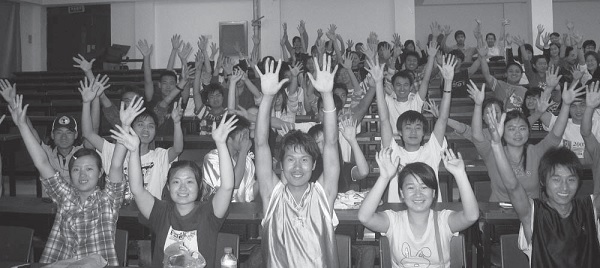
▲Raise your hands above your head and wave them vigorously. This is the clearest "applause" for deaf people!
Schools for the deaf usually arrange dormitories for children from far away, and dormitory life breeds rich deaf culture. When the seniors told stories in sign language, they naturally improved their sign language skills; the scene of chatting and laughing together at night left indelible sweet memories. Generally speaking, hearing students like holidays and don't like the start of school; however, deaf students are just the opposite. They like the start of school and don't like holidays, because only in school can they enjoy the joy of "speaking freely."
When a deaf child is born in a family, the parents must be extremely sad, desperate and find it difficult to accept it. Many parents seek medical treatment everywhere, even going bankrupt. Until they find that their children cannot be cured, they have no choice but to accept the fact. However, most parents will still try their best to educate their children to learn to speak.
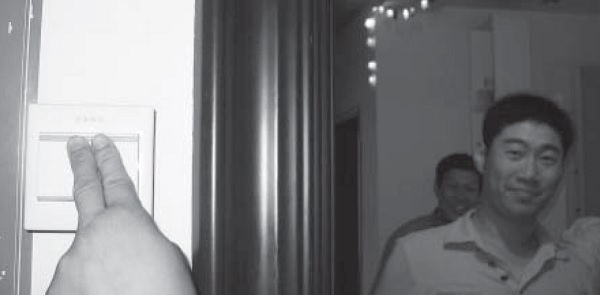
▲When you press the doorbell, the string of colorful lights in the house twinkles, informing the owner: "A distinguished guest is coming!"
The core of culture─sign language
With the development of special education - preschool education for deaf children, language rehabilitation, and attending mainstream schools in regular classes, etc., it has indeed produced positive effects on the oral education of deaf students. However, oral language education and sign language education should be complementary rather than mutually exclusive. If sign language is prohibited in order to learn spoken language, not only will they be unable to integrate into the rich original deaf culture, but they will also become marginalized people in the hearing culture.
In order to integrate deaf people into mainstream society, oral education is needed for deaf students. However, after all, only a few outstanding students have succeeded. In preschool education and lower grade education, deaf students have a certain foundation of spoken language through hearing aids and oral language training. However, as the grades increase, the demand for knowledge doubles. It is difficult to learn and transmit knowledge with natural sign language that is easy for deaf people to understand. It is absolutely necessary. Take Gallaudet University, Washington, DC, in the United States as an example. This is the only deaf humanities university in the world. In its history of nearly 150 years, it has trained tens of thousands of deaf people. Talent. Because of the sound American Sign Language (American Sign Language) system, deaf people can receive more advanced doctoral and master's education.
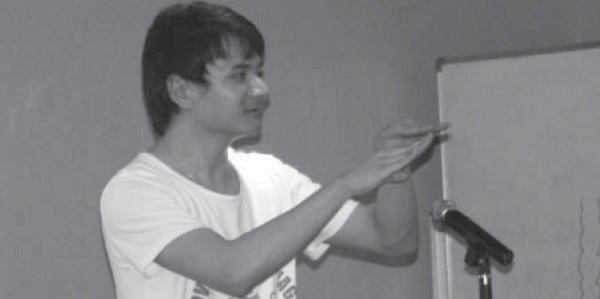
▲Sign language is the core of deaf culture. With smooth finger gestures and delicate expressions and movements, the voices and emotions of deaf people are vividly expressed.
Sign language is the language of the deaf. In order to provide better education for the deaf, the research and development of sign language is indispensable. At present, in many countries, due to the trend of deaf education returning to the mainstream, schools for the deaf have shrunk or even closed. The author believes that the direction of deaf education should not blindly return to the mainstream of spoken language, but should teach students in accordance with their aptitude according to their individual differences. Deaf schools are the most valuable asset of Deaf culture and should be cherished and developed. Generations of deaf people trained by Deaf schools shoulder the important mission of inheriting Deaf culture.
Deaf community─experience of returning home
Deaf culture is brewed in deaf schools and preserved and passed down in the deaf community.
Schein與Stewart(1995)清楚地描述3Schein and Stewart (1995) clearly describe 3: "The Deaf community has no geographical boundaries and zip code. What factors make up the Deaf community? First, common interests; second, sign language expression and sharing of this interest; and then active pursuit of Methods to contact other deaf people include: deaf organizations, deaf publications, and social gatherings. These methods do not require them to move their homes, but they can still maintain an appropriate distance and greet and communicate with each other frequently and naturally. "So you want to ask: "Where is the deaf community?" The answer is: "Wherever deaf people gather, that is the deaf community."
Professor Lee Jun-woo of Gangnam University in South Korea (2004) described the deaf community as:
(1) It can bring a sense of psychological stability to deaf people;
(2) Deaf sign language can be widely used to allow deaf people to communicate freely;
(3) A place where deaf people take the lead and deaf culture is at the center. 44
In the sign language corner of Beihai Park in Beijing, a group of deaf people gather together every Friday morning to chat and laugh; in Lu Xun Park in Shanghai, deaf people also gather regularly every Wednesday morning. When they get together, they don't talk about life philosophy or national affairs. As long as they have the opportunity to chat and talk about their hearts with their deaf friends, they are satisfied. Regardless of spring, summer, autumn or winter, no matter how hot or cold the weather is, there will always be deaf people gathering at the sign language corner to chat at a fixed time and in the same place. Due to hearing and communication barriers, most deaf people are more or less isolated in the workplace, so they cherish any opportunity to get together. Whenever we are together, there are always endless "hands-on words"; when we say goodbye, we are always reluctant to leave.
Schein與Stewart(l995)描述一位聾大學生,由於在聽人學校接受教育及成長過程中,從未遇過聾人。他回憶第一次遇到聾人群體的感受:「終於,我開始回家了。那是一種愛的經驗,不再覺得自己像是異鄉客,現在的我更像是社會中的一份子。」5許多在聽人世界成長的聾人第一次接觸聾人群體時,都有類似的感受。聾人社區會讓聾人產生強烈的歸屬感;換句話說,能以自己的語言自由自在地交流,發揚聾人文化的精髓,絕對有其存在的必要價值。
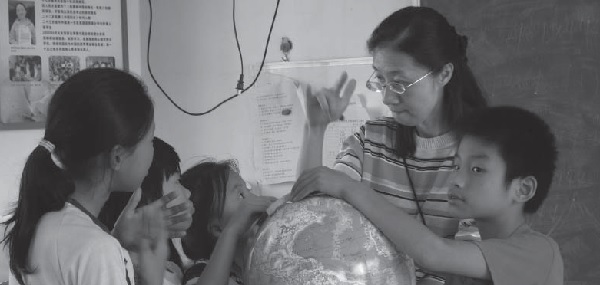
▲Lin Mianjun devotes himself to the education of deaf children in China and wants to give them a pair of wings to fly to the world and pursue their dreams.
ethnic minorities with their own language
When the concept of Deaf culture spread to Asia, first of all, a group of Deaf people gathered in Japan and proposed the "Deaf Culture Declaration" - Deaf people are a minority group with their own language. Korean deaf educator and sign language research expert Kim Chil-gwan also mentioned: "The Deaf Culture Declaration has brought great repercussions in the deaf community, that is, deaf people are not viewed from the perspective of pathological disabilities, but as having independent language and Look at them from a cultural perspective.”
Japanese deaf community leaders Kimura, Mineuchi and Ichida (2002) mentioned in the book "Understanding Deaf Culture": In 1991, the 11th World Conference on the Deaf was held in Japan. Four years later, Japan began to see The dawn of the Deaf Culture Manifesto. Jiang Zhuhai, a leader of the Korean deaf community, mentioned that the awareness of deaf culture has begun to have an impact on the Japanese deaf community. Since the implementation of the Deaf Culture Declaration, successful cases have increased day by day. Japan has given birth to two deaf lawyers and several deaf doctors. Jiang Zhuhai believes that such achievements have surprised and envied South Korea, which is neighboring Japan. 66
The history of deaf education in China has just celebrated its 120th anniversary. With social progress and the development of special education, deaf people have more and more opportunities to participate in society. It is hoped that the dawn of the Deaf Culture Declaration will also shine on the more than 20 million deaf compatriots in mainland China. Deaf people will no longer be labeled as disabled, and they will be accepted as a group with a unique language and culture. Through the recognition and promotion of deaf culture, deaf people can not only establish a healthy self-image, but also develop their potential talents and wisdom to contribute to the country and society.
Not being able to hear, see, or walk are all regrets in life. In addition to many inconveniences in life, they often even bring pain and despair. However, there are precious promises in the Bible, which are our greatest comfort and hope.
“The wilderness and the dry land shall rejoice, and the desert shall rejoice; and as the rose bloometh, it shall bloom with joy and with joy, and with shouts of joy. To it shall be given the glory of Lebanon, and the beauty of Carmel and Sharon. You will see the glory of the Lord and the beauty of our God.
At that time, the eyes of the blind will be opened, and the ears of the deaf will be unstopped. Then the lame will leap like deer, and the tongues of the mute will sing. There will be waters in the wilderness, and rivers in the desert. ” (Isaiah 35:1-2, 5-6)
Notes
1. Chief editor Zhao Yuping (1997), "Master of Sign Language", Taipei: Modern Classic Culture Co., Ltd.
2. Same as note 1.
3. Jerome D. Schein and David A. Stewart (1995), Language in Motion — Exploring the Nature of Sign, Gallaudet University Press.
4. Lee Joon-woo (2004), "Deaf People and Sign Language", Seoul: Humanity and Welfare.
5. Same as note 3.
6. Kimura, Mineuchi and Ichida (2002), "Understanding Deaf Culture", compiled by the Deaf Society Information Service, Seoul: Deaf Society Information Service.
 Journalist profile
Journalist profile
Lin Mianjun, a Korean overseas Chinese. After graduating from National Taiwan Normal University, he taught at Taipei Qicong Education (School for the Deaf) for six years. It has been involved in the ministry of deaf people in mainland China since 1995. After receiving a master's degree in deaf education from Gallaudet University in the United States in 2007, he established a sign language research institution in Shandong. Currently dedicated to research on Chinese Sign Language and Deaf culture.
